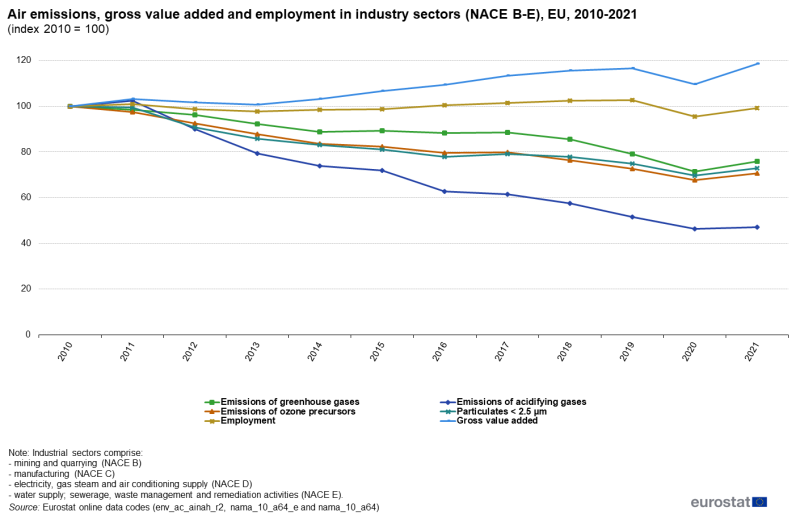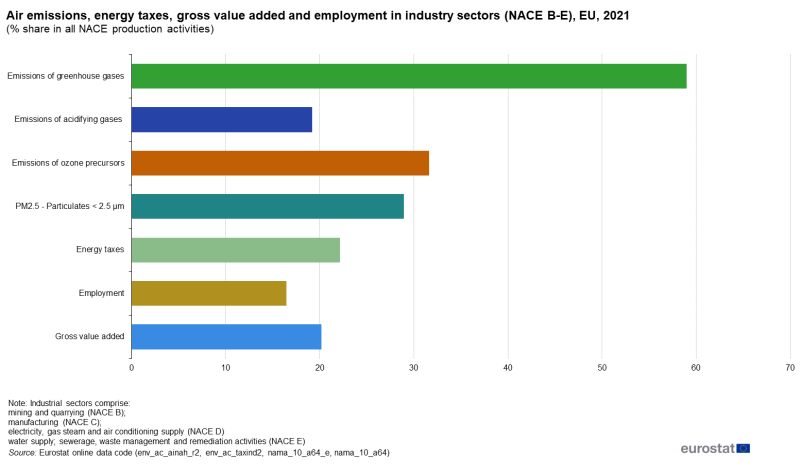Industrial emission statistics
Data extracted in January 2024
Planned article update: January 2025
Highlights
Between 2010 and 2021, EU industrial emissions to air decreased significantly while industry's gross value added increased by 19 %.
Air emissions, gross value added and employment in industry sectors (NACE B-E), EU, 2010-2021
Industry (NACE B, C, D, E) is an important sector of the economy of the European Union (EU), helping to generate value added and jobs. At the same time, industrial sector activities also result in pressures on the environment such as emissions to air. This article compares the socio-economic and environmental performance of the EU's industry sector.
Full article
General overview
Between 2010 and 2021, industrial emissions of greenhouse gases and air pollutants that damage human health and the environment decreased in the EU. At the same time, the value added generated by industry increased. Employment in the industrial sectors remained stable during this period.
Industrial emissions falling despite industrial growth
Between 2010 and 2021, industrial emissions decreased (see Figure 1). The largest decrease was recorded for emissions of acidifying gases with -53 %, followed by ozone precursor substances and particulates smaller than 2.5 µm (PM2.5) with -29 % and -27 %, respectively. Greenhouse gas emissions released by industrial sectors fell by -24 %. During the same period, the economic value generated by the industrial sector – measured in gross value added (GVA) – increased by 19 %. Employment in industrial sectors – measured in thousand hours worked – remained stable between 2010 and 2021, decreasing only by -1 %.

(Index 2010 = 100)
Source: Eurostat (env_ac_ainah_r2) (nama_10_a64_e) (nama_10_a64)
Socio-economic and environmental profile of industrial sectors
Figure 2 presents the socio-economic and environmental profile of industrial sectors, showing how much industrial sectors contribute to energy taxes, to total employment and to total GVA. It also shows the share of industrial emissions in total production-related air emissions.

(% share in all NACE production activities)
Source: Eurostat (env_ac_ainah_r2) (nama_10_a64_e) (nama_10_a64) (env_ac_taxener)
In 2021, the industrial share in greenhouse gas emissions was 59 %, while it was 32 % for ozone precursor emissions and 29 % for particulates smaller than 2.5 µm. Acidifying gases emitted by industry sectors amounted to 19 % of the total acidifying emissions by production activities.
In the same year, industrial sectors:
- contributed 20 % to the total GVA of the EU economy;
- generated 22 % of the EU's energy tax revenues;
- accounted for 16 % of the total employment in the EU (measured in hours worked).
Source data for tables and graphs
Data sources
This article presents data on emissions of greenhouse gases (GHG emissions), ozone precursors, acidifying gases and particulates smaller than 2.5 µm emitted by industry sectors (NACE B, C, D, E) in the EU. The main data source is Eurostat's air emissions accounts (AEAs) based on Regulation (EU) No 691/2011 on European environmental economic accounts, which are fully comparable with macroeconomic statistics. Greenhouse gases comprise carbon dioxide (CO2), nitrous oxide (N2O), methane (CH4) and fluorinated gases (hydrofluorocarbons (HFC), perfluorocarbons (PFC), sulphur hexafluoride (SF6) and natrium trifluoride (NF3). These greenhouse gases are aggregated taking into account their different capacities to cause global warming. The global warming potential (GWP) of each gas is defined in relation to a given weight of carbon dioxide (known as carbon dioxide equivalents: CO2 equivalents). The weighting factors currently used are the following:
- carbon dioxide: 1;
- methane: 28;
- nitrous oxide: 265;
- sulphur hexafluoride: 23 500.
Hydrofluorocarbons and perfluorocarbons comprise a large number of different gases that have different GWPs. Acidifying gases comprise sulphur dioxide (SO2), nitrogen oxides (NOx) and ammonia (NH3). They are aggregated using respective acidifying potentials (expressed in SO2 equivalents). The following conversion factors are used:
- nitrogen oxides: 0.7;
- sulphur dioxide: 1.0;
- ammonia: 1.9.
Ozone precursors comprise non-methane volatile organic compounds (NMVOCs), nitrogen oxides (NOx), carbon monoxide (CO) and methane (CH4). They are aggregated using respective ground-level ozone forming potentials expressed in NMVOC equivalents. The following conversion factors are used:
- nitrogen oxides: 1.22;
- NMVOC: 1.0;
- carbon monoxide: 0.11;
- methane: 0.014.
Particulates contain microscopic solids or liquid droplets that are so small they can be inhaled and cause serious health problems. Some particles less than 10 micrometres in diameter can get deep into human lungs and some may even get into the bloodstream. Of these, particles less than 2.5 micrometres in diameter pose the greatest risk to health. AEAs record emission data by economic activity, using the NACE classification. This arrangement enables an integrated environmental-economic analysis to be carried out in order to supplement national accounts. The scope encompasses production by all businesses resident in the country, including those operating ships, aircraft and other transportation equipment in other countries. For this article, the following NACE production activities are grouped together to denote the industry sector:
- mining and quarrying – NACE section B;
- manufacturing – NACE section C;
- electricity, gas, steam and air conditioning supply – NACE section D;
- water supply; sewerage, waste management and remediation activities – NACE section E.
Gross value added (GVA) is an important macroeconomic indicator derivable from national accounts. Gross value added is related to gross domestic product (GDP). While the latter monitors economic growth at the economy-wide level, the former monitors the economic performance of individual production activities and sectors. Employment is a significant socio-economic phenomenon. It can be measured in several ways. This article uses a volume measure expressed in hours actually worked annually. An environmental tax is a tax whose tax base is a physical unit (or a proxy) of something that has a proven, specific negative impact on the environment and which is defined in the European System of Accounts (ESA 2010) as a tax. For analytical purposes, the environmental taxes are divided into four categories: energy taxes (including CO2 taxes), transport taxes, pollution and resource taxes. This article uses data on energy taxes. Data on environmental taxes are collected based on Regulation (EU) N° 691/2011 on European environmental economic accounts.
Context
The European Green Deal aims to achieve sustainable development. Assessing the sustainability of production and consumption activities requires the simultaneous monitoring of economic, social and environmental indicators. Under the heading of 'industrial emissions', the European Commission (Environment) lists a range of EU actions to make industry more sustainable and reduce industrial emissions.
Direct access to
See also
- Air emissions accounts (env_air_aa)
- env_ac_ainah_r2
- env_ac_aibrid_r2
- env_ac_aigg_q